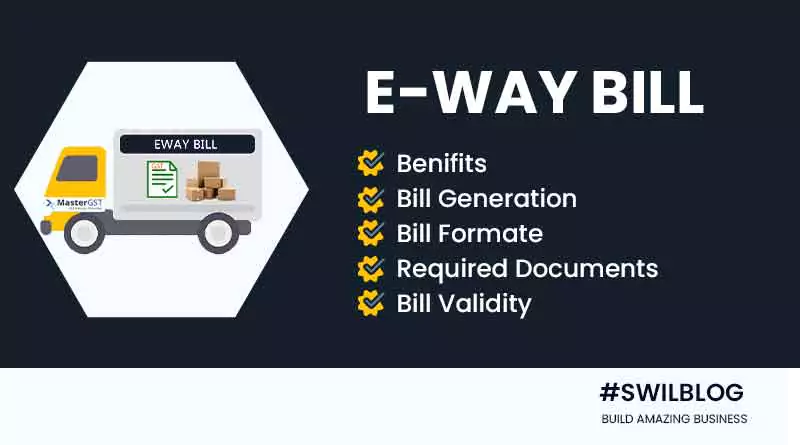On 1 April 2018, the government introduced an electronic-way bill system for inter-state transactions. It is mandatory to generate goods worth more than INR 50,000 while transporting. Subsequently, by 1 June 2018, it also became necessary to issue an E-way bill for intra-state supply to taxpayers.
Electronic-way bill is not new in the Indian taxation system. It was accepted in most states under the previous VAT regime in the name of road permits, way-bills, etc. At that time the main purpose of this tax lane was to investigate tax evasion, which used to happen during the movement of goods. / From a state. In a way, it is generally necessary for the consigner to consign the bill with the goods on their movement.
Earlier, it was state-specific, so it had to be generated through -specific state portals.
Now it comes under the GST regime with more informed capabilities. It consists of a uniform set of rules applicable throughout the country and generated electronically on the E-way bill portal.
What is E-way Bill?
E-way bill is another major reform under the Goods and Services Tax (GST) regime for tracking goods movement. It is typically required to accompany goods on their movement from the consignor to the consignee. It is governed by a uniform set of rules applicable throughout the country. It is generated electronically on the E-way bill portal.
The Electronic-way bill system creates a facility for transporters to raise complaints, in case a vehicle is detained for more than 30 minutes. This way, it ensures various benefits to the industry.
Benefits of E-way bill reform
- Elimination of check-posts
- Smooth movement of goods within a state and across various state borders
- Boost logistics ecosystem of the country
- Facilitate lesser traffic on major transportation routes
- Reduction in transportation costs
- Save time by replacing physical check posts with mobile squads
Objectives of E- Way Bill
The Electronic-way bill is an effective compliance mechanism that has the main objective to reduce any kind of tax evasion. It ensures that all the relevant details for the goods are uploaded before the goods are dispatched. This way, an individual will not be able to provide misleading information in goods invoices. The bill has two parts,
Part A-
It contains details of the goods being moved, the supplier, and the recipient.
Part B-
It contains relevant transportation details.
Under Electronic-way bill , the Radio Frequency Identification Devices (RFID) is used that helps buyers and sellers to track their goods.
When is an E-way bill Generated?
An E-way bill is required when a movement of goods of value more than Rs 50,000. It is generated by the registered company before the commencement of the movement. It must contain the details of the goods being transported. This movement of goods can be because of any of the following-
- Supplying of raw material or other things
- Returns or exchange or purposes other than supply
- Inward supply through the unregistered person
Who Generates the E-way Bill?
The E-way bill should be generated by:
- Registered person
- Unregistered person
- Transporter
If the E-way bill is generated by the registered person then it is required that the bill is generated through the portal or other means on the movement of goods amounting to Rs 50000 or more. Even if the value of goods is under Rs 50000, the bill can be generated.
If the Electronic-way bill is generated by the unregistered person to a registered one, then in such case, the registered one will be liable to do the compliance and makes sure all formalities are complete.
If the E-way bill is generated by the transporter, – this case arises when the supplier has missed on generating or providing an Electronic-way bill to a transporter. Thus, it is required of the transporter to generate on while carrying goods by air, rail, or road.
Know the Electronic-way bill Format
- Part A of FORM GST INS-01 needs to be filled online on the GST Portal by the registered supplier.
- Part B of FORM GST INS-01 needs to be filled by the registered person or the recipient of goods.
- Part A and B of FORM GST INS-01 need to be filled by the registered person who hands over goods to the transporter.
- FORM GST INS-01 needs to be filled by the transporter of goods if it is not done by the consignor.
- E-way bills need to be generated through FORM GST INS-01 by the supplier or the transporter for the supplies. If the supplier is unregistered and the recipient is registered then the recipient can be treated as the supplier.
- If multiple consignments are scheduled to be transported in one conveyance, the separate E-way bills will be generated. Into this, the transporter needs to mention the serial number of each E-way bill in the FORM GST INS-02 and will generate a consolidated bill on the Portal.
- The E-way bills can be verified at any time by his empowered authority. A report of which will be recorded by the authority in Part A of FORM GST INS – 03 within 24 hours of the inspection.
- The final report of the inspection is to be recorded in Part B of FORM GST INS – 03 within 3 days of the inspection.
- Lastly, the FORM GST INS- 04 will be used to upload the information in case if a vehicle has been detained for more than 30 minutes for non-compliance with E-way bill rules.
Things to Remember for Electronic-way bill generation
What are the documents required to generate an Electronic-way bill ?
- GSTIN of the registered taxpayer/ transporter, if registered
- Registered Mobile number with the GST system
What is the validity of the E-way Bill?
The validity period will be counted from the time of generation of the E-way Bill.
- Less than100 km- 1 day
- Every additional 100 km- additional 1 day
Role of GST Billing software in generating E-way bills
The GST E-way bill is mandatory for the concerned business persons, suppliers, and transporters. With the introduction of the E-way bill system by the government, they are now looking for a reliable E-way bill software solution for the smooth and fast creation of the E-way bill.
SWIL’s RetailGraph comes with a fully GST billing and e-filing system. It integrates the E-way bill system to create E-way bills for transportation in India to its users. It handles GST return filing and the creation of GST compliance bills and invoices. Its Electronic-way bill facility makes the company’s delivery easy. With this, it ensures hassle-free transportation of goods with few clicks to create GST E-way bills for companies and their delivery drivers.
The software also provides customization and makes it easier to run taxable operations in the post-GST regime. RetailGraph software allows users to create quick GST compliance bills to ensure smooth transportation of their goods across the country. The software is quite easy to use and has a variety of features and options to make the Electronic-way bill generation and verification process easier.
The software comes with the following features that help you to get the best E-way bill generation solution.
- Registration
- Bill Generation
- Bill Consolidation
- Bill Updation
- Bill Validation
- Import/Export
- Bill Cancellation/ Rejection
- Bill Print
- Auto-filtering of Bill by Status
- Bill Records
If you have more query on this, let’s contact us or request us for free software demo and gets real-time visibility into the software. Also, take advantage of our 45 days free trial of E-Way Bill Software that will help you in establishing trust in software credibility.







